Ethics and Financial Services in Commonwealth Bank
VerifiedAdded on 2024/04/25
|9
|2222
|90
AI Summary
Contribute Materials
Your contribution can guide someone’s learning journey. Share your
documents today.

MAA250 – Ethics and Financial
Services
Trimester 3, 2017
Assignment 2
1
Services
Trimester 3, 2017
Assignment 2
1
Secure Best Marks with AI Grader
Need help grading? Try our AI Grader for instant feedback on your assignments.
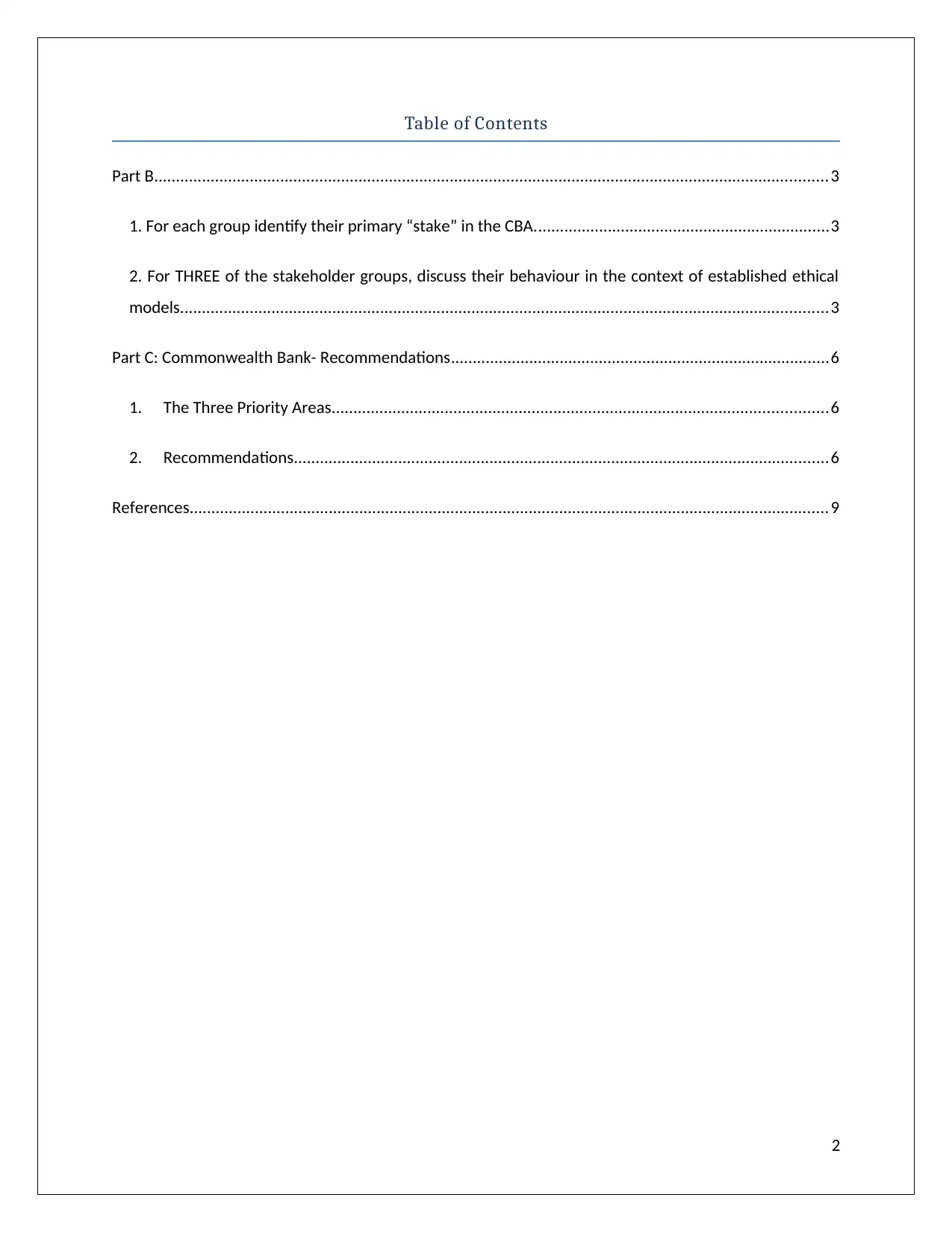
Table of Contents
Part B...........................................................................................................................................................3
1. For each group identify their primary “stake” in the CBA....................................................................3
2. For THREE of the stakeholder groups, discuss their behaviour in the context of established ethical
models.....................................................................................................................................................3
Part C: Commonwealth Bank- Recommendations.......................................................................................6
1. The Three Priority Areas..................................................................................................................6
2. Recommendations...........................................................................................................................6
References...................................................................................................................................................9
2
Part B...........................................................................................................................................................3
1. For each group identify their primary “stake” in the CBA....................................................................3
2. For THREE of the stakeholder groups, discuss their behaviour in the context of established ethical
models.....................................................................................................................................................3
Part C: Commonwealth Bank- Recommendations.......................................................................................6
1. The Three Priority Areas..................................................................................................................6
2. Recommendations...........................................................................................................................6
References...................................................................................................................................................9
2
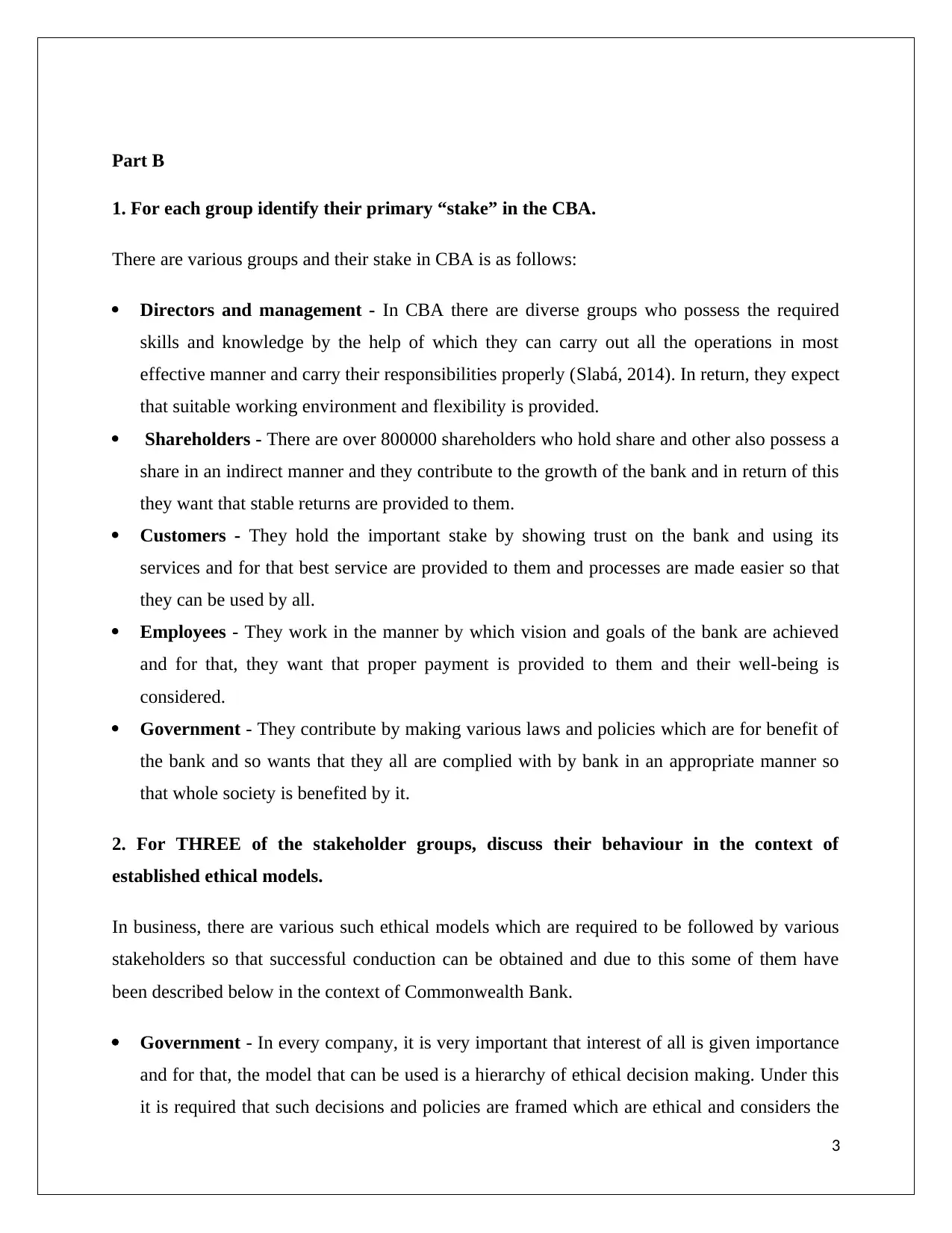
Part B
1. For each group identify their primary “stake” in the CBA.
There are various groups and their stake in CBA is as follows:
Directors and management - In CBA there are diverse groups who possess the required
skills and knowledge by the help of which they can carry out all the operations in most
effective manner and carry their responsibilities properly (Slabá, 2014). In return, they expect
that suitable working environment and flexibility is provided.
Shareholders - There are over 800000 shareholders who hold share and other also possess a
share in an indirect manner and they contribute to the growth of the bank and in return of this
they want that stable returns are provided to them.
Customers - They hold the important stake by showing trust on the bank and using its
services and for that best service are provided to them and processes are made easier so that
they can be used by all.
Employees - They work in the manner by which vision and goals of the bank are achieved
and for that, they want that proper payment is provided to them and their well-being is
considered.
Government - They contribute by making various laws and policies which are for benefit of
the bank and so wants that they all are complied with by bank in an appropriate manner so
that whole society is benefited by it.
2. For THREE of the stakeholder groups, discuss their behaviour in the context of
established ethical models.
In business, there are various such ethical models which are required to be followed by various
stakeholders so that successful conduction can be obtained and due to this some of them have
been described below in the context of Commonwealth Bank.
Government - In every company, it is very important that interest of all is given importance
and for that, the model that can be used is a hierarchy of ethical decision making. Under this
it is required that such decisions and policies are framed which are ethical and considers the
3
1. For each group identify their primary “stake” in the CBA.
There are various groups and their stake in CBA is as follows:
Directors and management - In CBA there are diverse groups who possess the required
skills and knowledge by the help of which they can carry out all the operations in most
effective manner and carry their responsibilities properly (Slabá, 2014). In return, they expect
that suitable working environment and flexibility is provided.
Shareholders - There are over 800000 shareholders who hold share and other also possess a
share in an indirect manner and they contribute to the growth of the bank and in return of this
they want that stable returns are provided to them.
Customers - They hold the important stake by showing trust on the bank and using its
services and for that best service are provided to them and processes are made easier so that
they can be used by all.
Employees - They work in the manner by which vision and goals of the bank are achieved
and for that, they want that proper payment is provided to them and their well-being is
considered.
Government - They contribute by making various laws and policies which are for benefit of
the bank and so wants that they all are complied with by bank in an appropriate manner so
that whole society is benefited by it.
2. For THREE of the stakeholder groups, discuss their behaviour in the context of
established ethical models.
In business, there are various such ethical models which are required to be followed by various
stakeholders so that successful conduction can be obtained and due to this some of them have
been described below in the context of Commonwealth Bank.
Government - In every company, it is very important that interest of all is given importance
and for that, the model that can be used is a hierarchy of ethical decision making. Under this
it is required that such decisions and policies are framed which are ethical and considers the
3
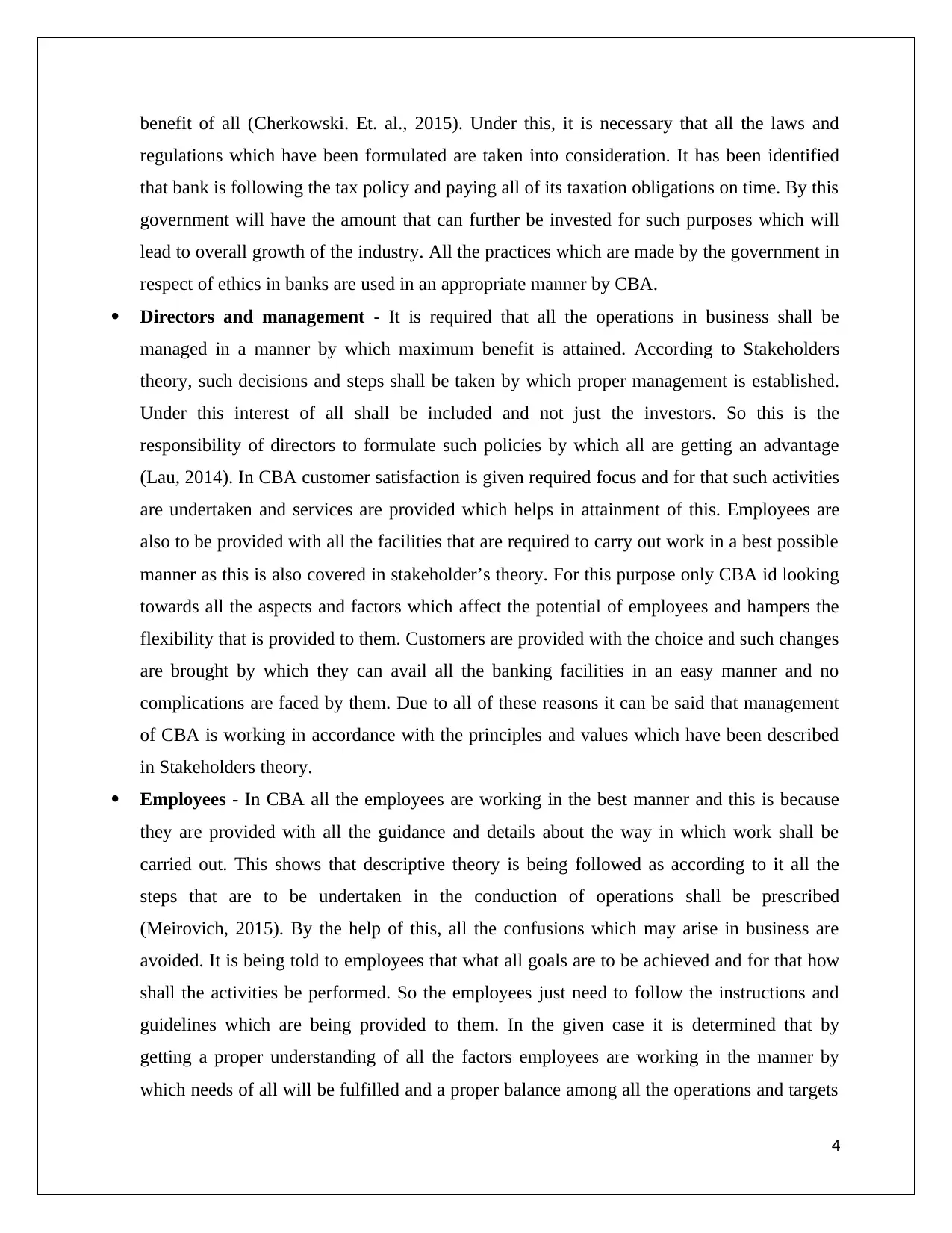
benefit of all (Cherkowski. Et. al., 2015). Under this, it is necessary that all the laws and
regulations which have been formulated are taken into consideration. It has been identified
that bank is following the tax policy and paying all of its taxation obligations on time. By this
government will have the amount that can further be invested for such purposes which will
lead to overall growth of the industry. All the practices which are made by the government in
respect of ethics in banks are used in an appropriate manner by CBA.
Directors and management - It is required that all the operations in business shall be
managed in a manner by which maximum benefit is attained. According to Stakeholders
theory, such decisions and steps shall be taken by which proper management is established.
Under this interest of all shall be included and not just the investors. So this is the
responsibility of directors to formulate such policies by which all are getting an advantage
(Lau, 2014). In CBA customer satisfaction is given required focus and for that such activities
are undertaken and services are provided which helps in attainment of this. Employees are
also to be provided with all the facilities that are required to carry out work in a best possible
manner as this is also covered in stakeholder’s theory. For this purpose only CBA id looking
towards all the aspects and factors which affect the potential of employees and hampers the
flexibility that is provided to them. Customers are provided with the choice and such changes
are brought by which they can avail all the banking facilities in an easy manner and no
complications are faced by them. Due to all of these reasons it can be said that management
of CBA is working in accordance with the principles and values which have been described
in Stakeholders theory.
Employees - In CBA all the employees are working in the best manner and this is because
they are provided with all the guidance and details about the way in which work shall be
carried out. This shows that descriptive theory is being followed as according to it all the
steps that are to be undertaken in the conduction of operations shall be prescribed
(Meirovich, 2015). By the help of this, all the confusions which may arise in business are
avoided. It is being told to employees that what all goals are to be achieved and for that how
shall the activities be performed. So the employees just need to follow the instructions and
guidelines which are being provided to them. In the given case it is determined that by
getting a proper understanding of all the factors employees are working in the manner by
which needs of all will be fulfilled and a proper balance among all the operations and targets
4
regulations which have been formulated are taken into consideration. It has been identified
that bank is following the tax policy and paying all of its taxation obligations on time. By this
government will have the amount that can further be invested for such purposes which will
lead to overall growth of the industry. All the practices which are made by the government in
respect of ethics in banks are used in an appropriate manner by CBA.
Directors and management - It is required that all the operations in business shall be
managed in a manner by which maximum benefit is attained. According to Stakeholders
theory, such decisions and steps shall be taken by which proper management is established.
Under this interest of all shall be included and not just the investors. So this is the
responsibility of directors to formulate such policies by which all are getting an advantage
(Lau, 2014). In CBA customer satisfaction is given required focus and for that such activities
are undertaken and services are provided which helps in attainment of this. Employees are
also to be provided with all the facilities that are required to carry out work in a best possible
manner as this is also covered in stakeholder’s theory. For this purpose only CBA id looking
towards all the aspects and factors which affect the potential of employees and hampers the
flexibility that is provided to them. Customers are provided with the choice and such changes
are brought by which they can avail all the banking facilities in an easy manner and no
complications are faced by them. Due to all of these reasons it can be said that management
of CBA is working in accordance with the principles and values which have been described
in Stakeholders theory.
Employees - In CBA all the employees are working in the best manner and this is because
they are provided with all the guidance and details about the way in which work shall be
carried out. This shows that descriptive theory is being followed as according to it all the
steps that are to be undertaken in the conduction of operations shall be prescribed
(Meirovich, 2015). By the help of this, all the confusions which may arise in business are
avoided. It is being told to employees that what all goals are to be achieved and for that how
shall the activities be performed. So the employees just need to follow the instructions and
guidelines which are being provided to them. In the given case it is determined that by
getting a proper understanding of all the factors employees are working in the manner by
which needs of all will be fulfilled and a proper balance among all the operations and targets
4
Paraphrase This Document
Need a fresh take? Get an instant paraphrase of this document with our AI Paraphraser
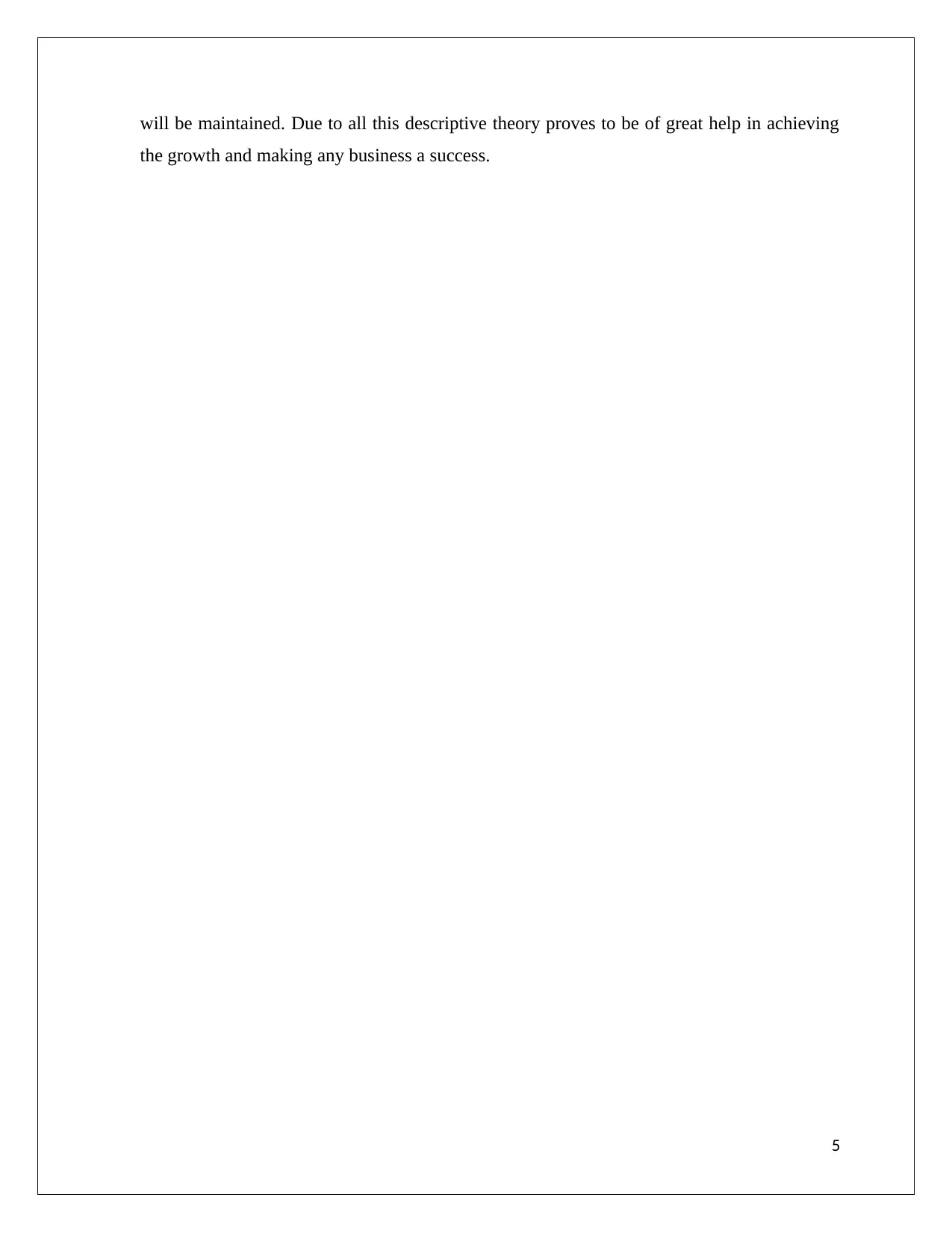
will be maintained. Due to all this descriptive theory proves to be of great help in achieving
the growth and making any business a success.
5
the growth and making any business a success.
5

Part C: Commonwealth Bank- Recommendations
To,
CBA’s Board of Directors
According to the consultant appointed by the Commonwealth Bank, to improve the CBA’s
reputation and trust there are many areas.
1. The Three Priority Areas are as under:
(i) The Board- the Corporate Governance to be effective requires a mechanism which must be
transparent and the decision was taken should be effective. The Board should make key changes
since it helps the board to emphasize on the processes through which the management will be
appointed and the risk governance will be strengthened. The AUSTRAC scandal, money
laundering which is not required to be repeated then the corporate governance is required
(Himaj, 2014)
(ii) Management- the board when planning any strategy to make the business effectively, it
should be implemented by the management. The management is responsible for the effective
working and decision making which will help in overall business reputation and trust. When the
management implements the board strategy then the senior executives will be satisfied.
(iii) Employees- The employees are a very important part of any business as without employees
the business would not be better. The behaviour of the employees should also be required to be
good against the colleagues and the consumers so that the business is done in a cooperative and
coordinated manner. The behaviour of the employees will make the people motivated and work
in a leading manner.
2. Recommendations
(i) The Board - The recommendation for the board to make changes in the corporate governance
should apply AAA 7-Step ethical decision making. The American Accounting Association
Model was founded on a report in 1990. The report included 7-steps through which the board can
6
To,
CBA’s Board of Directors
According to the consultant appointed by the Commonwealth Bank, to improve the CBA’s
reputation and trust there are many areas.
1. The Three Priority Areas are as under:
(i) The Board- the Corporate Governance to be effective requires a mechanism which must be
transparent and the decision was taken should be effective. The Board should make key changes
since it helps the board to emphasize on the processes through which the management will be
appointed and the risk governance will be strengthened. The AUSTRAC scandal, money
laundering which is not required to be repeated then the corporate governance is required
(Himaj, 2014)
(ii) Management- the board when planning any strategy to make the business effectively, it
should be implemented by the management. The management is responsible for the effective
working and decision making which will help in overall business reputation and trust. When the
management implements the board strategy then the senior executives will be satisfied.
(iii) Employees- The employees are a very important part of any business as without employees
the business would not be better. The behaviour of the employees should also be required to be
good against the colleagues and the consumers so that the business is done in a cooperative and
coordinated manner. The behaviour of the employees will make the people motivated and work
in a leading manner.
2. Recommendations
(i) The Board - The recommendation for the board to make changes in the corporate governance
should apply AAA 7-Step ethical decision making. The American Accounting Association
Model was founded on a report in 1990. The report included 7-steps through which the board can
6

be suggested of a process for decision making (Suleman, 2017). The AAA 7-step model includes
the following steps:
Determine the case facts: The board has to identify the places where they have to
implement changes in the corporate governance.
Ethical Issues of the case: The board should determine the legal actions in case any
fraud or illegal activity occurs during the business.
Principles, norms and values related: The Board is required to ensure that the bank is
working in a legal manner and the scandal or the money laundering will not occur in the
bank in future. The board should frame strict rules, values and principles so that the
business is done effectively.
Alternative courses of action: The board should decide whether they are able to cover
the losses incurred due to the malfunctions or illegal activity, or they are required to make
gain by removing the illegal activities.
The best course of action: The board should decide that the illegal activities and money
laundering acts are required to be stopped and this action will be consistent with the
values, rules or the principles framed by the board.
Consequences of both actions: If the board decides not to stop the illegal activity then
these activities will grow day by day and year by year and the bank will not be in a
position to work and grow. While, if the board decides to work according to the rules and
principles framed then the bank will be able to work in a legal and reputed manner.
Decision: The board should decide the second alternative where there are the chances for
the banks to work in a proper and effective manner and with better decision making.
(ii) Management - The management should be recommended to implement the descriptive
model of the ethical decision-making. The descriptive model should be such that the
management is able to work according to the legal, economic, morals and behavioural aspects.
The model should be implemented in such a manner so that the management is able to take
effective decisions. The model ensures that the process, judgment, system and development of
the bank should be integrated. The model implemented should be legal and should comply with
all the provisions of the bank. The model also ensures right, utilitarian and justice moral values
which make the business effective and reputed (Verma, 2014)
7
the following steps:
Determine the case facts: The board has to identify the places where they have to
implement changes in the corporate governance.
Ethical Issues of the case: The board should determine the legal actions in case any
fraud or illegal activity occurs during the business.
Principles, norms and values related: The Board is required to ensure that the bank is
working in a legal manner and the scandal or the money laundering will not occur in the
bank in future. The board should frame strict rules, values and principles so that the
business is done effectively.
Alternative courses of action: The board should decide whether they are able to cover
the losses incurred due to the malfunctions or illegal activity, or they are required to make
gain by removing the illegal activities.
The best course of action: The board should decide that the illegal activities and money
laundering acts are required to be stopped and this action will be consistent with the
values, rules or the principles framed by the board.
Consequences of both actions: If the board decides not to stop the illegal activity then
these activities will grow day by day and year by year and the bank will not be in a
position to work and grow. While, if the board decides to work according to the rules and
principles framed then the bank will be able to work in a legal and reputed manner.
Decision: The board should decide the second alternative where there are the chances for
the banks to work in a proper and effective manner and with better decision making.
(ii) Management - The management should be recommended to implement the descriptive
model of the ethical decision-making. The descriptive model should be such that the
management is able to work according to the legal, economic, morals and behavioural aspects.
The model should be implemented in such a manner so that the management is able to take
effective decisions. The model ensures that the process, judgment, system and development of
the bank should be integrated. The model implemented should be legal and should comply with
all the provisions of the bank. The model also ensures right, utilitarian and justice moral values
which make the business effective and reputed (Verma, 2014)
7
Secure Best Marks with AI Grader
Need help grading? Try our AI Grader for instant feedback on your assignments.
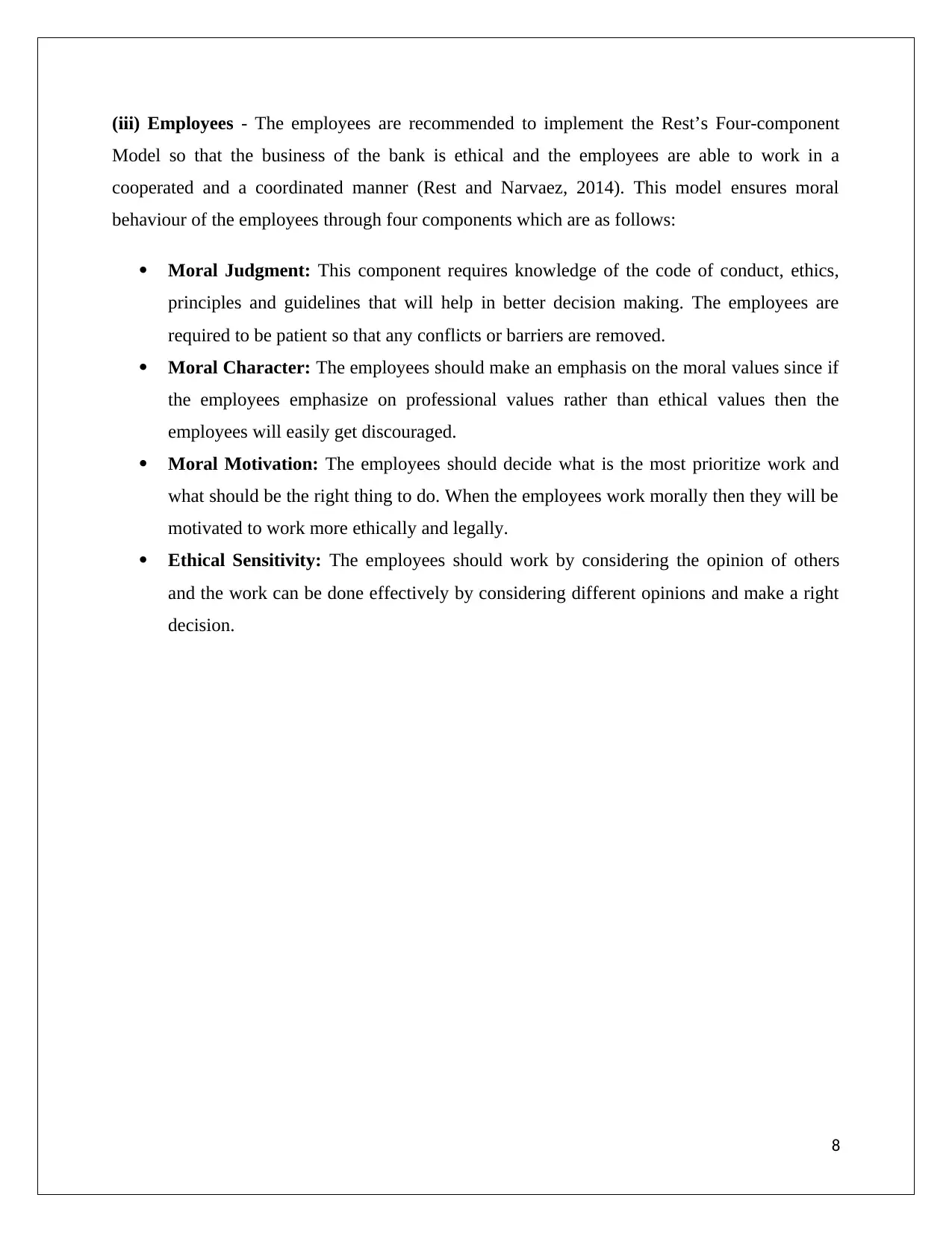
(iii) Employees - The employees are recommended to implement the Rest’s Four-component
Model so that the business of the bank is ethical and the employees are able to work in a
cooperated and a coordinated manner (Rest and Narvaez, 2014). This model ensures moral
behaviour of the employees through four components which are as follows:
Moral Judgment: This component requires knowledge of the code of conduct, ethics,
principles and guidelines that will help in better decision making. The employees are
required to be patient so that any conflicts or barriers are removed.
Moral Character: The employees should make an emphasis on the moral values since if
the employees emphasize on professional values rather than ethical values then the
employees will easily get discouraged.
Moral Motivation: The employees should decide what is the most prioritize work and
what should be the right thing to do. When the employees work morally then they will be
motivated to work more ethically and legally.
Ethical Sensitivity: The employees should work by considering the opinion of others
and the work can be done effectively by considering different opinions and make a right
decision.
8
Model so that the business of the bank is ethical and the employees are able to work in a
cooperated and a coordinated manner (Rest and Narvaez, 2014). This model ensures moral
behaviour of the employees through four components which are as follows:
Moral Judgment: This component requires knowledge of the code of conduct, ethics,
principles and guidelines that will help in better decision making. The employees are
required to be patient so that any conflicts or barriers are removed.
Moral Character: The employees should make an emphasis on the moral values since if
the employees emphasize on professional values rather than ethical values then the
employees will easily get discouraged.
Moral Motivation: The employees should decide what is the most prioritize work and
what should be the right thing to do. When the employees work morally then they will be
motivated to work more ethically and legally.
Ethical Sensitivity: The employees should work by considering the opinion of others
and the work can be done effectively by considering different opinions and make a right
decision.
8
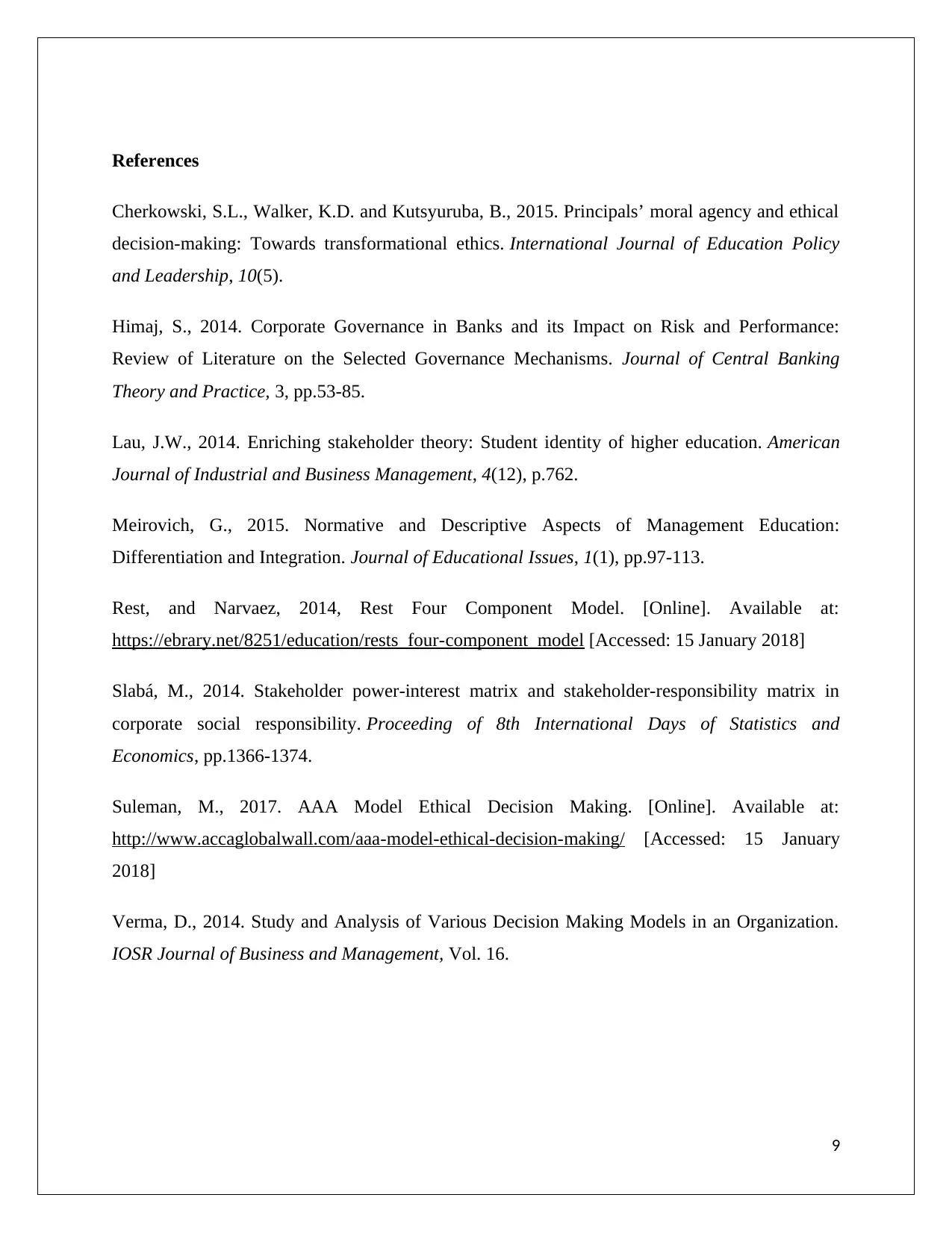
References
Cherkowski, S.L., Walker, K.D. and Kutsyuruba, B., 2015. Principals’ moral agency and ethical
decision-making: Towards transformational ethics. International Journal of Education Policy
and Leadership, 10(5).
Himaj, S., 2014. Corporate Governance in Banks and its Impact on Risk and Performance:
Review of Literature on the Selected Governance Mechanisms. Journal of Central Banking
Theory and Practice, 3, pp.53-85.
Lau, J.W., 2014. Enriching stakeholder theory: Student identity of higher education. American
Journal of Industrial and Business Management, 4(12), p.762.
Meirovich, G., 2015. Normative and Descriptive Aspects of Management Education:
Differentiation and Integration. Journal of Educational Issues, 1(1), pp.97-113.
Rest, and Narvaez, 2014, Rest Four Component Model. [Online]. Available at:
https://ebrary.net/8251/education/rests_four-component_model [Accessed: 15 January 2018]
Slabá, M., 2014. Stakeholder power-interest matrix and stakeholder-responsibility matrix in
corporate social responsibility. Proceeding of 8th International Days of Statistics and
Economics, pp.1366-1374.
Suleman, M., 2017. AAA Model Ethical Decision Making. [Online]. Available at:
http://www.accaglobalwall.com/aaa-model-ethical-decision-making/ [Accessed: 15 January
2018]
Verma, D., 2014. Study and Analysis of Various Decision Making Models in an Organization.
IOSR Journal of Business and Management, Vol. 16.
9
Cherkowski, S.L., Walker, K.D. and Kutsyuruba, B., 2015. Principals’ moral agency and ethical
decision-making: Towards transformational ethics. International Journal of Education Policy
and Leadership, 10(5).
Himaj, S., 2014. Corporate Governance in Banks and its Impact on Risk and Performance:
Review of Literature on the Selected Governance Mechanisms. Journal of Central Banking
Theory and Practice, 3, pp.53-85.
Lau, J.W., 2014. Enriching stakeholder theory: Student identity of higher education. American
Journal of Industrial and Business Management, 4(12), p.762.
Meirovich, G., 2015. Normative and Descriptive Aspects of Management Education:
Differentiation and Integration. Journal of Educational Issues, 1(1), pp.97-113.
Rest, and Narvaez, 2014, Rest Four Component Model. [Online]. Available at:
https://ebrary.net/8251/education/rests_four-component_model [Accessed: 15 January 2018]
Slabá, M., 2014. Stakeholder power-interest matrix and stakeholder-responsibility matrix in
corporate social responsibility. Proceeding of 8th International Days of Statistics and
Economics, pp.1366-1374.
Suleman, M., 2017. AAA Model Ethical Decision Making. [Online]. Available at:
http://www.accaglobalwall.com/aaa-model-ethical-decision-making/ [Accessed: 15 January
2018]
Verma, D., 2014. Study and Analysis of Various Decision Making Models in an Organization.
IOSR Journal of Business and Management, Vol. 16.
9
1 out of 9
![[object Object]](/_next/static/media/star-bottom.7253800d.svg)





